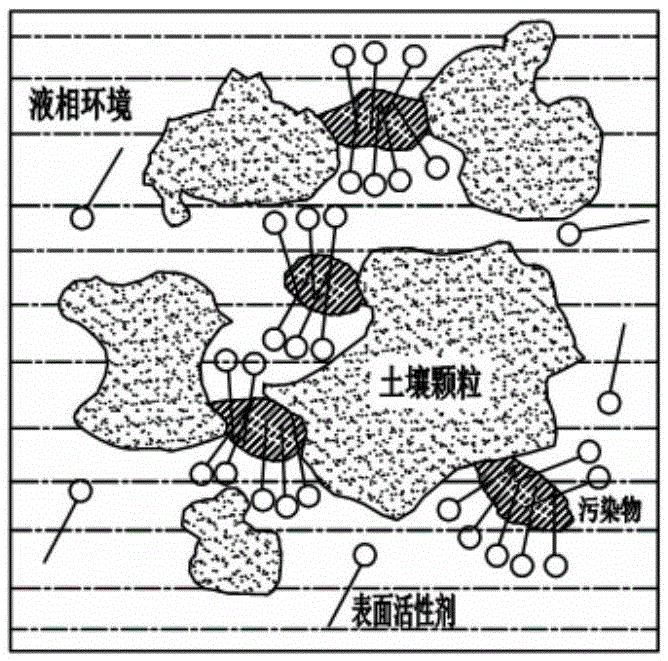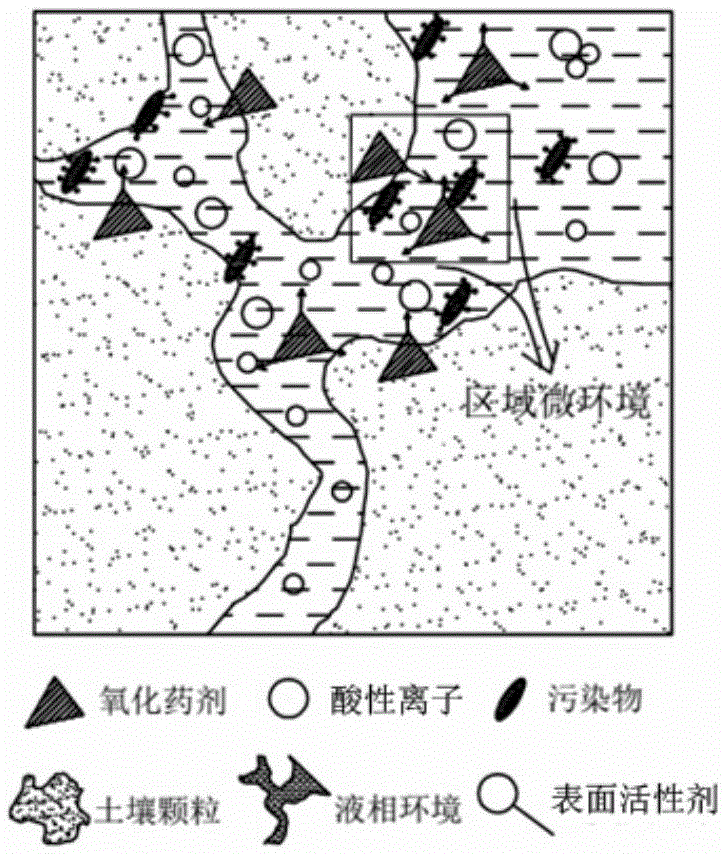Method for restoring organophosphorus pesticide contaminated soil
A technology for organophosphorus pesticides and polluted soil, applied in the field of remediation of organophosphorus pesticide-contaminated soil, can solve problems such as unsatisfactory remediation of organophosphorus pesticide-contaminated soil, and achieve the effects of accelerated reaction participation, strong engineering practicability, and accelerated heterogeneous migration.
- Summary
- Abstract
- Description
- Claims
- Application Information
AI Technical Summary
Problems solved by technology
Method used
Image
Examples
Embodiment 1
[0038] 1. Take 500g of soil polluted by organophosphorus pesticides in a pesticide factory in Tianjin after screening (concentration is 3342mg / Kg), add 5g of solid sodium hydroxide, and stir evenly;
[0039] 2. Measure 200mL of polyethylene glycol aqueous solution with a mass fraction of 1%, add it to the soil in the above step and stir evenly, the pH is 9-10;
[0040] 3. Seal the soil after dosing according to the above steps for 3 days, and keep the soil moisture during storage and maintenance;
[0041] 4. Add 10g of activated persulfate to the soil after conditioning and decomposing and stir well;
[0042] 5. Add 10mL sulfuric acid aqueous solution with a volume fraction of 1:1, the pH is 5-6, while stirring rapidly;
[0043] 6. Seal and stockpile the soil after repairing according to the above steps, keep the soil moisture for 1 day and send it for inspection.
[0044]Send inspection, detection method is as follows (other embodiments are connected with this detection met...
Embodiment 2
[0048] 1. Take 500g of soil polluted by organophosphorus pesticides in a pesticide factory in Tianjin after screening (concentration is 6782mg / Kg), add 8g of solid sodium hydroxide, and stir evenly;
[0049] 2. Measure 180mL of polyethylene glycol aqueous solution with a mass fraction of 2%, add it to the soil in the above step and stir evenly, the pH is 10-11;
[0050] 3. Seal the soil after dosing according to the above steps for 2 days, and keep the soil moisture during storage and maintenance;
[0051] 4. Add 15g of solid potassium ferrate to the above-mentioned conditioned and heaped soil and stir well;
[0052] 5. Add 38mL sulfuric acid aqueous solution with a volume fraction of 1:1, the pH is 3-4, while stirring rapidly;
[0053] 6. Seal and stockpile the soil after repairing according to the above steps, keep the soil moisture for 2 days and send it for inspection.
[0054] The results showed that the concentration of organophosphorus pesticides in the repaired soil ...
Embodiment 3
[0056] 1. Take 500g of soil polluted by organophosphorus pesticides in a pesticide factory in Tianjin after screening (concentration is 3478mg / Kg), add 8g of solid potassium hydroxide, and stir evenly;
[0057] 2. Measure 50mL of polyethylene glycol aqueous solution with a mass fraction of 5%, add it to the soil in the above step and stir evenly, the pH is 10-11;
[0058] 3. Seal the soil after dosing according to the above steps for 3 days, and keep the soil moisture during storage and maintenance;
[0059] 4. Add 10g of solid potassium permanganate to the above-mentioned soil after conditioning and decomposing, and stir well;
[0060] 5. Add 34mL sulfuric acid aqueous solution with a volume fraction of 1:1, the pH is 3-4, while stirring rapidly;
[0061] 6. Seal and stockpile the soil after repairing according to the above steps, keep the soil moisture for 2 days and send it for inspection.
[0062] The results show that the concentration of organophosphorus pesticides in ...
PUM
 Login to View More
Login to View More Abstract
Description
Claims
Application Information
 Login to View More
Login to View More - R&D
- Intellectual Property
- Life Sciences
- Materials
- Tech Scout
- Unparalleled Data Quality
- Higher Quality Content
- 60% Fewer Hallucinations
Browse by: Latest US Patents, China's latest patents, Technical Efficacy Thesaurus, Application Domain, Technology Topic, Popular Technical Reports.
© 2025 PatSnap. All rights reserved.Legal|Privacy policy|Modern Slavery Act Transparency Statement|Sitemap|About US| Contact US: help@patsnap.com



